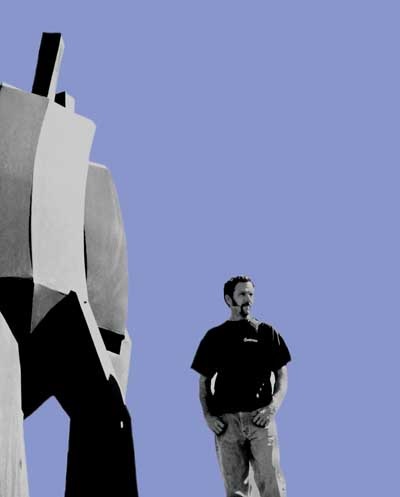He’s Grown Accustomed to This Place: An Interview with Salt Lake sculptor Cordell Taylor
Community
Much has happened since SLUG ran a 2001 cover story on local sculptor Cordell Taylor. Then, Taylor expressed his frustration with our local government and business owners’ lack of support for the arts, as well as gallery goers’ lack of appreciation for the amount of effort and money required to make and exhibit contemporary art. The last six years have seen the demise of The Cordell Taylor Gallery (575 West 200 South), the fizzling of the Olympic torch and the descent of the Gateway Mall, just one part of the Salt Lake real estate boom.
Still, for Taylor, little has changed when it comes to support of the arts. When asked what single change might make Salt Lake a better place for artists, Taylor does not hesitate; “The city needs to make studio space available.” Taylor insists that the presence of artists inevitably brings value to any property, that art has the capacity to regenerate neighborhoods. Despite this, Taylor claims Salt Lake maintains a “divide and conquer” mentality with regard to artistic communities. As soon as a group of creative types unites to form a “neighborhood,” rents soar and artists are left to do the cucaracha.
Taylor has found a far different state of affairs overseas. Participating in a summer-residence symposium in Dobrichovice, Czech Republic, Taylor has had the opportunity not only to work with foreign artists but also to see how a foreign public responds to works quite challenging our standards. “I remember traveling through rural villages,” Taylor said, “and I would find abstract sculptures in the middle of the town square. No one thought they were strange or out of place.” He says this same attitude pervades Czech culture, where the artisan is far more the norm than the exception. “Quality craftsmanship is everywhere; in restaurants the plates and the glasses are all handmade.”
Though he chooses to continue living in Utah, Taylor has gone to Dobrichovice every summer for the last four years as a guest of the Fabian Symposium. There, Taylor worked on a commissioned monumental piece destined for a public sculpture garden. In addition to the work and companionship displayed by the two other artists in the program, one Italian and the other Czech, Taylor was impressed with the local government’s interest in the art displayed in town. “When I was finished, the mayor came out to meet me and see my work,” Taylor remarked. “That kind of concern isn’t frequent here in Utah.”
Taylor, who sculpts in a variety of styles, has also produced a substantial body of print work. He toured me through his small but comfortable studio while holding his new baby in one arm. With his free hand he peruses a collection of wooden studies displayed on shelves extending to the ceiling. “I made all the chairs, too,” he tells me. He scans his scale-models as if selecting a favorite volume from his library. Every surface here is burnished metal, worn wood or oiled and lived-in leather. The effect marries the tobacco-grunge charm of a cobbler’s shop with the studiousness of a rare-bookseller’s.
This connoisseurship of the worn, seasoned and familiar pervades much of Taylor’s work. Though his sculptures frequently recall those of modern masters, Taylor’s distinguish themselves through their emphasis of touch as opposed to sight. Instead of making stainless steel seem to evaporate into pure light (as for example, David Smith does with his Cubis), Taylor’s geometric forms soften into flesh. “I leave them outdoors to let them age and mellow,” he tells me.
These pieces do not demand that viewers stand back and react to them like paintings. Instead, the surfaces (warm as tempera and pastel) of these almost-wooly iron slabs invite the hand to draw near, to handle and interact with them like horses, cows and other cattle. For all that he may quote Paris and New York, Taylor’s work is unmistakably Utahn. Rather than rarefying the city or gallery until it has become abstract space (i.e., no place at all), Taylor’s monuments open Salt Lake outward, restore it to its former condition as pasture and farmland.
Taylor’s Deconstruction Series plays with familiarity in other ways. “I made them out of pipe and scaffolding scrapped after a university-sponsored bridge-building competition,” he says. These tracery pieces take on the weightlessness of Picasso’s cubist drawings. However, the cleanliness of the materials and the neatness of the figures Taylor describes do not recall the charcoal and newsprint on which Picasso labored to reinvent painting. Instead, they recall the rapid play of zigs and zags made with an Etch-A-Sketch.
The Deconstructions conjure not violence (too quickly associated with the term) so much as a sense of the bodily joy so integral to literary deconstruction. Taylor’s metal drawings, such as Order of Chaos and Circus, allude to a child’s sudden exhilaration when shaking a sketch to start over again. This approachability, evident in Taylor’s personality as much as his art, allows him, despite his growing international stature, to remain wholly and wonderfully local.
Cordell Taylor currently works out of his studio at Art Space on Pierpont Avenue. He lives with his wife Lenka Konopasek, also an important Salt Lake artist, and their new son, Roman.
